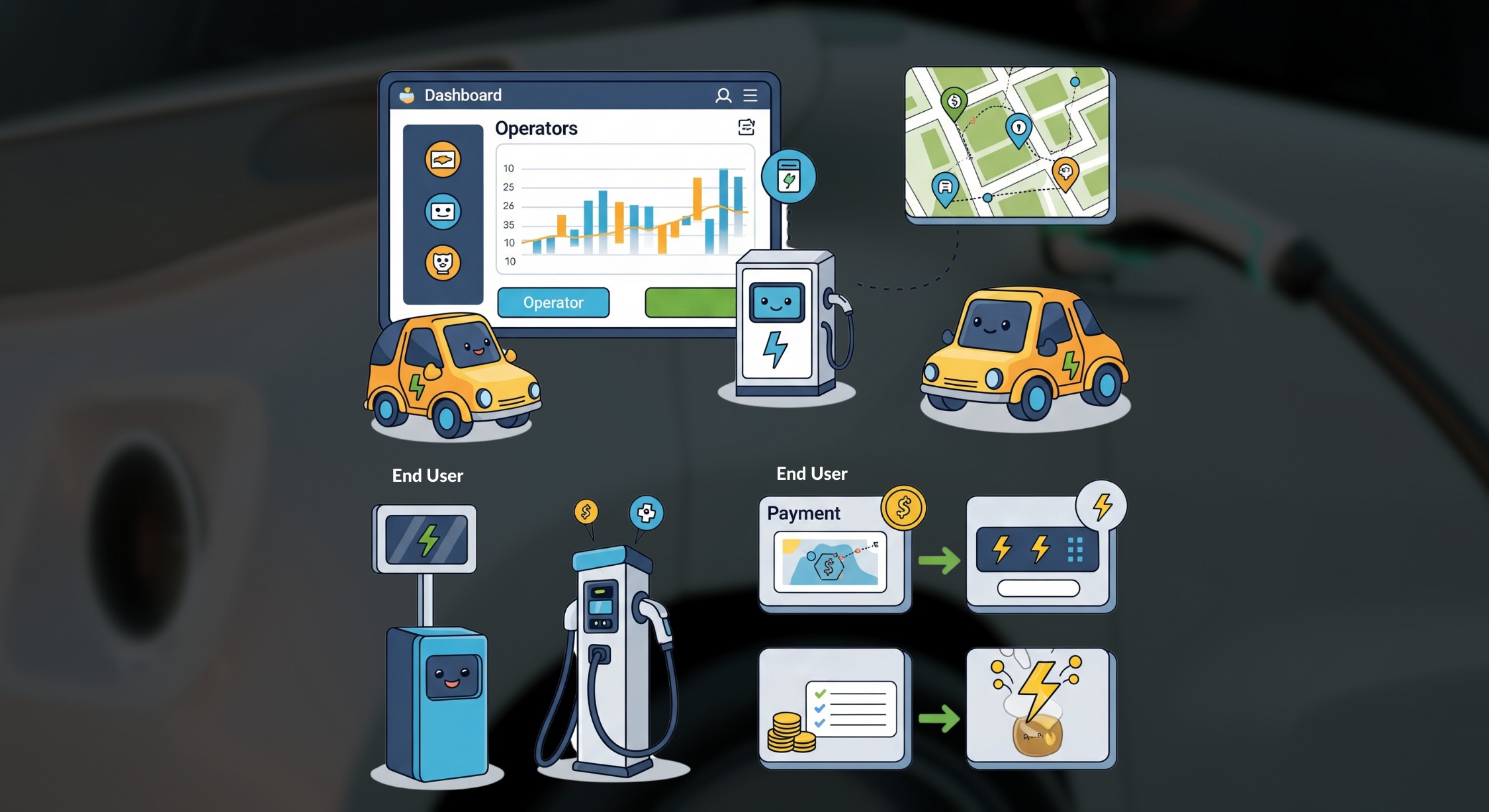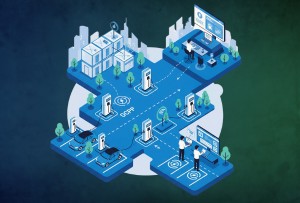The EV revolution needs more than fast chargers. It needs smart, future-ready tech. At Experion, we develop software that bridges devices, data, and user experiences. From infrastructure to interface, we build what keeps electric mobility moving.
As more countries commit to net-zero targets and automakers pivot to all-electric lineups, EVs are shifting rapidly from novelty to necessity. But the real challenge isn’t just building better cars, it’s building the smart, scalable infrastructure to support them. Charging stations are springing up across highways, parking lots, workplaces, and apartment complexes, but with different vendors, platforms, and networks involved, one question becomes critical: how do all these systems talk to each other?
At this point, the Open Charge Point Protocol (OCPP) becomes essential.
Think of OCPP as the common language of EV charging, a standard that enables chargers and management systems to communicate seamlessly, regardless of brand, model, or location. Without it, every new charging station could become a digital silo, forcing users and operators into fragmented, incompatible systems. But with OCPP, the entire charging ecosystem becomes interoperable, intelligent, and ready to grow.
This blog dives into what makes OCPP the invisible engine of the EV revolution! How it works, why it matters, and what it means for businesses, developers, and everyday drivers.
What is Open Charge Point Protocol (OCPP)?

The Open Charge Point Protocol (OCPP) is a communication standard that facilitates interaction between an EV charging station (also known as an Electric Vehicle Supply Equipment or EVSE) and a central charge point management system (CPMS). Developed by the Open Charge Alliance (OCA), a global consortium of public and private sector companies, its primary purpose is to ensure interoperability and standardization within the EV charging ecosystem. OCPP is an “open standard,” meaning its specifications are publicly available, fostering a competitive market and enabling diverse manufacturers and software developers to build compatible solutions. This openness is crucial, as it avoids vendor lock-in and promotes flexibility for both charge point operators and EV drivers.
Evolution of OCPP: From OCPP 1.5 to OCPP 2.0.1
OCPP has undergone significant evolution to keep pace with the rapid advancements in EV technology and charging infrastructure needs.
- OCPP 1.5: An earlier widely adopted version that established the foundational communication messages for starting/stopping charging sessions, sending meter values, and status updates. It laid the groundwork for basic charger-to-network communication.
- OCPP 1.6: This version introduced WebSocket communication, enhancing efficiency and enabling new functionalities like smart charging (load balancing) and firmware updates. It became a very popular and stable version, still widely in use today.
- OCPP 2.0 and 2.0.1: These represent a major leap forward, designed to address the growing complexities of EV charging. OCPP 2.0.1, the latest stable version, brings enhanced security, improved smart charging capabilities, comprehensive device management, and support for advanced features required by modern charging networks. It reflects a deeper understanding of the entire charging ecosystem, including energy management and payment systems.
Key Features of the Open Charge Point Protocol

Core functionalities: Communication between EV chargers and management systems
At its heart, the OCPP protocol enables bi-directional communication, allowing the central management system to send commands to the charger (e.g., start/stop charging, set schedules) and for the charger to send data back to the system (e.g., meter readings, status updates, error messages). This continuous dialogue is essential for remote management and monitoring of charging infrastructure.
Key features in OCPP 2.0.1
OCPP 2.0.1 introduces or significantly enhances several critical features:
- Security enhancements (e.g., TLS encryption): Recognizing the importance of securing sensitive charging and payment data, OCPP 2.0.1 mandates and improves security by incorporating Transport Layer Security (TLS) encryption for communication. It also includes robust device certificate management and enhanced authorization mechanisms, protecting against unauthorized access and cyber threats.
- Smart charging capabilities: This version offers advanced functionalities for intelligent energy management. It allows for sophisticated load balancing across multiple chargers, integration with grid services for demand-response programs, and optimized charging schedules based on energy prices or grid stability. This is crucial for managing grid strain as EV adoption increases.
- Support for firmware updates and diagnostics: OCPP 2.0.1 significantly improves remote management capabilities. It allows charge point operators to remotely push firmware updates to chargers, ensuring they always have the latest features and security patches. Furthermore, it provides extensive diagnostic capabilities, enabling remote troubleshooting and reducing the need for on-site maintenance, thereby minimizing downtime.
The Role of EV Charger OCPP in Charging Infrastructure
How EV chargers with OCPP ensure compatibility across different manufacturers
Before OCPP, a charge point operator might be forced to use chargers and management software from the same vendor, creating proprietary “walled gardens.” With OCPP, any EV charger that is compliant with the protocol can communicate with any OCPP-compliant central management system, regardless of the manufacturer. This means a single software platform can manage a diverse fleet of chargers from various brands, simplifying operations for charge point owners and offering more choice.
Advantages of OCPP in reducing vendor lock-in for businesses and users
The most significant advantage of OCPP is the drastic reduction in vendor lock-in. For businesses investing in charging infrastructure (e.g., fleet operators, workplaces, public charging networks), this means they are not beholden to a single provider for both hardware and software. They can choose the best hardware for their needs and pair it with their preferred management software, or even switch software providers without having to replace their entire charging station infrastructure. For EV users, this translates to a more reliable and consistent charging experience, as their vehicle can generally charge at any OCPP-compliant station, regardless of the brand.
Real-world examples of OCPP-based EV chargers in public and private use
OCPP has become the de facto standard for EV charging networks globally. You can find OCPP-based EV chargers in a multitude of settings:
- Public Charging Networks: Major public charging networks worldwide (e.g., those operated by utility companies, fuel station chains, or dedicated charging service providers) heavily rely on OCPP to manage their vast networks of chargers, enable remote monitoring, and process payments.
- Workplace Charging: Many companies offering EV charging as an employee perk use OCPP-compliant chargers connected to a central system for billing, access control, and usage reporting.
- Residential Apartments and Condos: Multi-unit dwellings installing shared EV charging often leverage OCPP to manage access, allocate costs, and monitor charger health.
- Fleet Depots: Commercial fleets transitioning to EVs use OCPP-enabled chargers to manage their charging infrastructure, optimize charging schedules, and track energy consumption for their electric vehicles.
Building an OCPP Based EV Charging Application

Overview of an OCPP-based EV charging application: Features and benefits
Developing an EV charging application that leverages OCPP is crucial for charge point operators to manage their infrastructure, provide services to EV drivers, and integrate with other systems.
An OCPP-based EV charging application (often referred to as a Charge Point Management System or CPMS) is the software brain that communicates with and controls the physical EV chargers. Such an application typically provides a dashboard for operators to monitor their network and offers features for end-users to find, activate, and pay for charging sessions.
Key features typically include:
- Remote Control: Starting, stopping, and resetting charging sessions.
- Monitoring: Real-time status of chargers (available, charging, out of order), energy consumption, and session data.
- User Management: Registering users, managing payment methods, and setting access permissions.
- Pricing and Billing: Configurable pricing structures and automated billing based on energy consumed or time.
- Reporting: Generation of reports on usage, revenue, and charger uptime.
Benefits of such an application include:
- Centralized Control: Manage an entire network of chargers from a single interface.
- Improved Efficiency: Automate tasks, reduce manual intervention, and improve operational workflows.
- Enhanced User Experience: Provide EV drivers with a seamless way to find, use, and pay for charging.
- Data-Driven Insights: Collect valuable data on charging patterns, energy consumption, and network performance.
- Future-Proofing: Leverage the open standard to adapt to new charger models and technologies.
As EV networks grow, so do the challenges in control and compliance. Experion builds future-proof platforms that handle scale, support diverse hardware, and simplify management with precision.
Key Components of an OCPP-based app
- Charging station management: This core module handles the communication with individual EV chargers using the OCPP protocol. It processes messages from chargers (e.g., “boot notification,” “meter values,” “status notification”) and sends commands to them (e.g., “remote start transaction,” “reset,” “firmware update”). It maintains the operational state of each charger and logs all interactions.
- User interfaces for monitoring and control: This includes both an operator-facing dashboard and potentially a public-facing mobile or web application for EV drivers. The operator dashboard allows for real-time monitoring of charger status, troubleshooting, configuration management, and comprehensive reporting. The user interface for drivers enables finding available chargers, initiating and stopping charging, viewing session details, and managing payment.
- Integration with payment systems and smart grid solutions: A robust OCPP-based application must integrate with various external systems. This includes payment gateways (e.g., credit card processors, mobile payment solutions) for seamless billing. For smart grid integration, it might connect with energy management systems, utility companies, or grid operators to participate in demand-response programs, optimize charging based on renewable energy availability, or balance grid load.
Challenges in developing and maintaining an OCPP-compliant application
Developing and maintaining a robust OCPP-compliant EV charging application comes with its own set of challenges:
- Protocol Complexity: While open, OCPP (especially 2.0.1) is a complex protocol with many message types and scenarios. Thorough understanding and correct implementation are crucial.
- Interoperability Testing: Despite the standard, variations in manufacturer implementations can lead to subtle interoperability issues requiring extensive testing with various charger models.
- Scalability: The application must be designed to scale efficiently as the number of connected chargers and users grows exponentially.
- Security: Implementing strong security measures to protect sensitive data (user information, payment details) and prevent unauthorized access to chargers is paramount.
- Real-time Performance: The application needs to handle real-time communication with numerous chargers simultaneously, requiring robust backend infrastructure and efficient data processing.
- Integration with Legacy Systems: Integrating with older, non-OCPP compliant chargers or existing backend systems can add complexity.
- Staying Up-to-Date: The OCPP protocol itself continues to evolve, requiring ongoing development and maintenance to support newer versions and features.
Benefits of Open Charge Point Protocol for Different Stakeholders

The widespread adoption of the Open Charge Point Protocol (OCPP) delivers tangible, far-reaching benefits for everyone involved in the EV ecosystem, from end-users to infrastructure developers and technology providers. Each stakeholder sees unique advantages as the protocol continues to unlock the full potential of interoperability and innovation.
For EV Owners
Seamless charging experience across different locations:
For EV drivers, the value of OCPP is experienced daily in the form of charging convenience. Gone are the days when drivers had to worry about whether their vehicle would be compatible with a particular charging station. With EV charger OCPP compliance, users enjoy a unified experience—plugging into a charger from any manufacturer, anywhere on the road, with the same confidence as fueling up at a traditional gas station. Whether you’re at home, in a mall parking lot, or navigating a cross-country trip, OCPP ensures the process is smooth, consistent, and predictable. That level of reliability significantly reduces range anxiety, encouraging more drivers to embrace electric mobility.
For Businesses
Scalability and reduced costs for charging networks:
For businesses like fleet operators, real estate developers, retailers, and charge point operators, OCPP is a game-changer. It allows for modular growth; companies can start small, then expand by integrating chargers from different vendors without overhauling their backend systems. This standardization not only trims integration costs but also drives down hardware prices due to the increased supplier competition. A cloud-based investment in OCPP-based EV charging applications also minimizes operational overhead, as businesses can centralize control, automate diagnostics, and update firmware without sending a technician to every station. The outcome? More reliable infrastructure at a lower total cost of ownership.
For Developers and Manufacturers
Easier integration and innovation within the ecosystem:
For developers and charger manufacturers, OCPP represents a well-documented, stable foundation upon which to build. No longer is there a need to reinvent the wheel or create proprietary systems for every new project. With OCPP as a universal protocol, innovation can be focused on advanced features, like predictive maintenance, AI-powered analytics, and energy optimization, rather than basic connectivity. Developers creating an OCPP based EV charging application can build once and deploy anywhere, confident that their software will communicate seamlessly with any compliant charger on the market. This cross-compatibility fosters a dynamic marketplace, rich in diverse, interoperable solutions.
Future of the OCPP in the EV Industry
The Open Charge Point Protocol is not merely a snapshot of today’s standards; it is a living framework, designed to evolve in tandem with the fast-changing world of electric vehicles. As EV adoption surges and technology transforms, OCPP is expected to adapt and lead.
Emerging trends in EV charging and their implications for OCPP
A variety of future-facing developments are already shaping how OCPP will grow:
- Public and Destination Charging Expansion:
With EVs becoming the default choice for many, the need for ubiquitous charging infrastructure—in cities, on highways, and in parking garages—will skyrocket. Managing these networks will require robust, scalable protocols like OCPP. - Faster Charging Technologies:
As ultra-fast DC charging stations become more prevalent, OCPP’s real-time communication features will need to support instantaneous control and feedback loops, ensuring safety and efficiency at high energy loads. - Renewable Energy Integration:
The transition to green energy is placing pressure on charging systems to be smarter. OCPP’s smart charging features allow chargers to coordinate with solar and wind energy sources, optimizing charge cycles based on peak generation times and supporting grid balancing. - Enhanced User Experience:
Future iterations of the protocol are expected to improve “plug-and-charge” functionality—where user identification, session start, and payment occur automatically, much like a toll booth using RFID. This will create an effortless, friction-free user journey.
Role of OCPP in enabling advancements like bi-directional charging and Vehicle-to-Grid (V2G) systems
The latest versions of OCPP, particularly 2.0.1, are built to support bi-directional energy flows, a technological leap that unlocks tremendous potential:
- Bi-directional Charging:
EVs equipped with this capability can serve not just as transportation but as power sources. During emergencies or high-demand periods, vehicles can discharge power back to homes or the grid. OCPP defines the standardized commands and responses to make this a secure, controlled process. - Vehicle-to-Grid (V2G):
A step further, V2G is a strategic grid management technique where thousands of EVs feed stored energy back into the grid to stabilize supply. With OCPP managing this two-way communication, utilities gain access to distributed energy storage without investing in new infrastructure, and EV owners can even monetize their parked vehicles.
The global push for adopting OCPP standards for sustainable growth
Governments and private sector players alike are pushing for OCPP standardization as a pathway to meet sustainability targets and accelerate electric mobility:
- Accelerating EV Adoption:
Interoperability encourages investment in EVs by removing user friction and infrastructure uncertainty. - Ensuring Grid Stability:
As millions of EVs plug into the grid, smart charging and V2G will be critical. OCPP provides the framework for managing this complexity. - Fostering Innovation and Fair Competition:
By eliminating closed ecosystems, OCPP promotes healthy competition and unlocks innovation across hardware and software providers. - Enabling Renewable Integration:
Through coordinated energy usage, OCPP helps align EV charging with renewable generation, contributing to net-zero goals.
How Experion Can Support You With OCPP Based Application

As a technology leader with deep expertise in connected systems and smart infrastructure, Experion Technologies offers end-to-end solutions for businesses aiming to build or enhance their EV charging ecosystem with the OCPP protocol.
- Custom OCPP Software Development:
We design tailored OCPP based EV charging applications for enterprises, municipalities, and commercial networks—whether it’s a bespoke CPMS or a driver-friendly mobile app. - OCPP Integration Services:
Our teams specialize in seamlessly integrating your existing systems (CRMs, billing platforms, energy providers) with your OCPP-compliant infrastructure. - Firmware Development and Remote Updates:
Experion supports the full device lifecycle, from developing OCPP-compliant firmware to enabling secure over-the-air updates and remote diagnostics. - Consulting and Advisory:
Unsure how to begin your OCPP journey? We provide strategic guidance, roadmap planning, and interoperability testing to help you build with confidence. - Cloud-Native Infrastructure:
Our platforms are designed for scale—deployable on cloud or hybrid models—to handle millions of real-time interactions, with robust security and performance at their core. - UI/UX Excellence:
Great technology is only as good as its interface. We craft intuitive and engaging user experiences for both charge point operators and EV drivers, boosting adoption and satisfaction.
Conclusion
The Open Charge Point Protocol (OCPP) is more than just a communication standard—it’s the backbone of the modern EV charging world. By providing a universally accepted framework for charger and software interaction, OCPP lays the groundwork for a future where EV adoption is widespread, charging is seamless, and infrastructure scales effortlessly.
From reducing vendor lock-in and enabling smart grid integration to supporting next-generation innovations like bi-directional charging and Vehicle-to-Grid capabilities, OCPP is the invisible engine driving the EV revolution. And as nations and companies double down on clean energy commitments, the protocol’s significance will only grow.
For businesses looking to ride the wave of this transformation, the opportunity lies in building with OCPP, not just to keep up, but to lead. And with a technology partner like Experion, you’re well-equipped to engineer that future, securely, smartly, and sustainably.
Key Takeaways
- OCPP enables interoperability between EV chargers and management systems, reducing vendor lock-in and promoting open ecosystems.
- OCPP 2.0.1 enhances smart charging, security, and diagnostics, making it ideal for the evolving needs of modern EV infrastructure.
- Experion builds scalable OCPP-based solutions, helping businesses manage large, diverse charger networks with precision.
- EV owners benefit from a consistent charging experience, with the ability to use any OCPP-compliant station across networks and brands.
- Businesses save on infrastructure costs by mixing and matching hardware and software, thanks to OCPP’s open standard.
- Developers and manufacturers accelerate time-to-market with OCPP’s clear, universal specifications, focusing more on innovation than compatibility issues.
- Real-world adoption spans public, residential, and fleet charging, showcasing OCPP’s flexibility across use cases.
- OCPP supports future-ready capabilities like bi-directional charging and Vehicle-to-Grid (V2G), enabling EVs to feed energy back to the grid.
- Experion offers end-to-end services from OCPP software development to cloud-native platforms and intuitive user interfaces.
- As EV adoption grows, OCPP will remain the digital backbone, and Experion is at the forefront of building what’s next in electric mobility.
From energy efficiency to platform agility, Experion delivers the software intelligence behind modern EV networks. Wherever the future of mobility goes, we’re already building the code that powers it.

